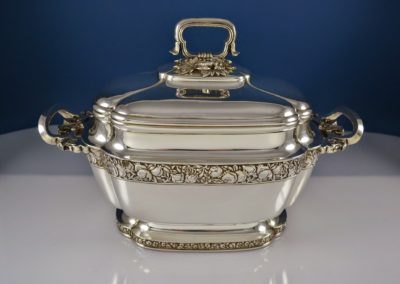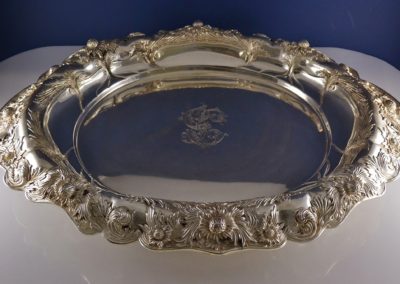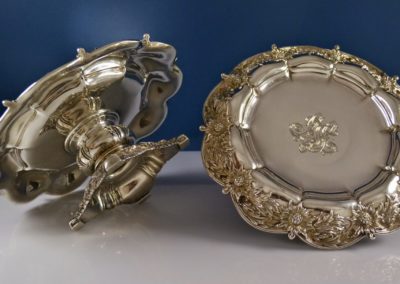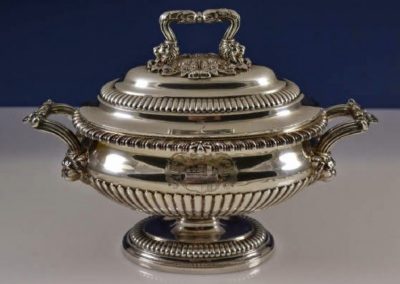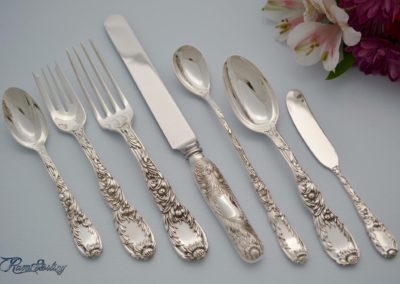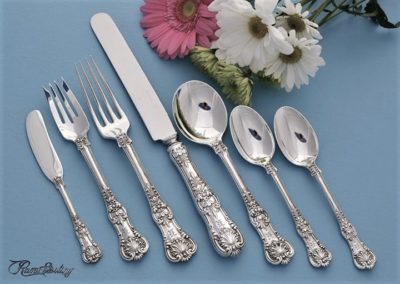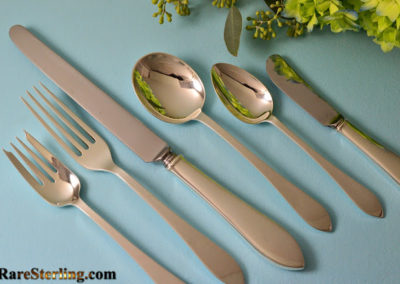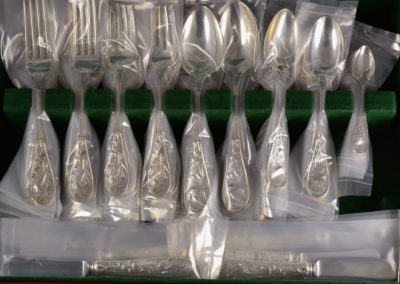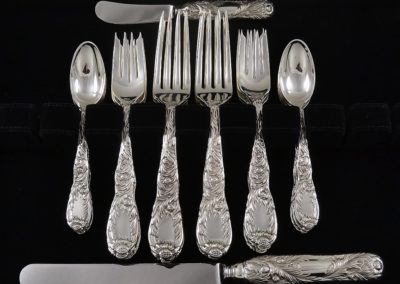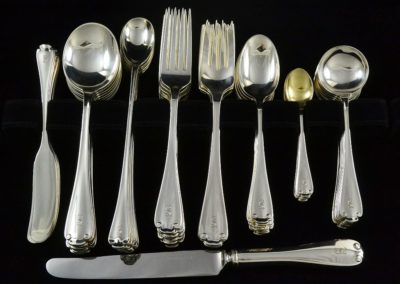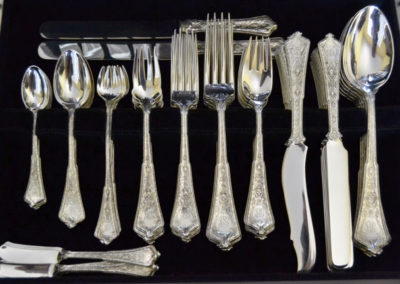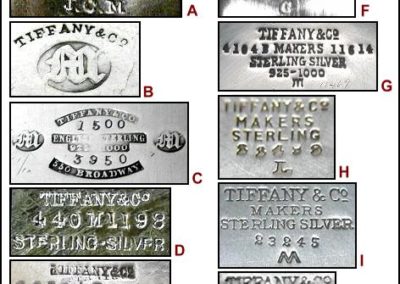Tiffany & Company Photos & History
We Buy Tiffany & Company Sterling Silver
Tiffany & Co. Sterling Silver
Below is our Tiffany & Company Sterling Silver Flatware and Hollowware Gallery. In addition, you will see a brief item description. As well, as a zoom feature for each image to take a closer look. Below the gallery you will find a brief writeup on the History of Tiffany and Company Silver. We hope that you enjoy our photos.
We are always looking to purchase Tiffany and Company sterling silver Hollowware and Flatware Sets. Most of all, complete sets or large pieces. Especially, Patterns in English Kings, Chrysanthemum and Audubon. If you Tiffany and Company Sterling Silver that you would like to sell, please Contact us at Raresterling.com
Tiffany & Company Gallery
Our Sterling Silver Images.
History of Tiffany & Co.
Read About Tiffany & Co.
Tiffany & Co. History
Tiffany & Co. Sterling Silver
Company History: Founded by Charles Lewis Tiffany and Teddy Young in New York City in 1837 as a “stationery and fancy goods emporium,” the store initially sold a wide variety of stationery items, and operated as Tiffany, Young & Ellis in Lower Manhattan.
The name was shortened to Tiffany & Co. in 1853 when Charles Tiffany took control, and the firm’s emphasis on jewelry was established. Tiffany & Co. has since opened stores in major cities all over the world. Unlike other stores at the time in the 1830s, Tiffany clearly marked the prices on its goods, as there would be no haggling for the price. In addition, against the social norm at the time, Tiffany only accepted cash payments, and did not accept payments on credit.
The first Tiffany’s mail order catalog, known as the “Blue Book,” was published in 1845 in the United States and it is still being published today. In 1862, Tiffany & Co. supplied the Union Army with swords (Model 1840 Cavalry Saber), flags and surgical implements. In 1867, Tiffany & Co. was the first US firm to win an award for the excellence in silverware at the Exposition Universelle in Paris. In 1877, an insignia that would become the famous New York Yankees “NY” logo was struck on a medal of honor by Tiffany & Co. and issued to the first NYC police officer shot in the line of duty. The Yankees adopted the logo in 1909. In 1878, Tiffany won the gold medal for jewelry and a grand prize for silverware at the Paris Exposition, which gave the Tiffany name added prestige. In 1868, Tiffany was incorporated. In 1887, Tiffany bought the French Crown Jewels which attracted publicity and further solidified the Tiffany brand’s connection to quality diamonds. The company revised the Great Seal of the United States in 1885. In 1902, after the passing of Charles Lewis Tiffany, his son, Louis Comfort Tiffany became the company’s first official Design Director.
In 1919, the company made a revision to the Medal of Honor on behalf of the United States Department of the Navy. This “Tiffany Cross” version was rare because it was awarded only for combat, using the previous design for non-combat awards. In 1942 the Navy established the Tiffany version for non-combat heroism, but in August 1942 the Navy eliminated the Tiffany Cross and the two-medal system. In 1956, legendary designer Jean Schlumberger joined Tiffany, and Andy Warhol collaborated with Tiffany to create Tiffany Holiday Cards (circa 1956-1962).
In 1968, US First Lady, Lady Bird Johnson commissioned Tiffany to design a White House china service, which featured 90 flowers. In November 1978 Tiffany & Co. was sold to Avon Products Inc. for about $104 million in stock. However, in a 1984 Newsweek article, it was noted that the Fifth Avenue Tiffany store had began stocking so many inexpensive items that it began looking like Macy’s during a white sale. Furthermore, customers complained about declining quality and service. In August 1984, Avon sold Tiffany to an investor group led by William R. Chaney, for $135.5 million in cash.
Tiffany went public again in 1987, and raised about $103.5 million by selling 4.5 million shares of common stock. Because of the 1990-1991 recession in the United States, Tiffany began to emphasize mass merchandising. A new campaign was started that stressed how Tiffany could be affordable for all; for instance, it advertised that diamond engagement rings started at $850. “How to Buy a Diamond” brochures were sent to 40,000 people who called a toll-free number specifically set up to target the larger population. However, to maintain its image as a luxury goods company, it continued to display high-style images in stores. In 2000, The Tiffany & Co. Foundation was established to provide grants to nonprofit organizations working in the environment and in the arts. In June 2004, Tiffany sued eBay, claiming that it was making profits from the sale of counterfeit Tiffany products. Tiffany lost at trial and on appeal (see Tiffany v. eBay for more details.) On January 28, 2008, it was announced that the Japanese mobile phone operator SoftBank and Tiffany & Co. had collaborated in making a limited 10 model-only cellphone. This cellphone contains more than 400 diamonds, totaling more than 20 carats (4.0 g). The cost is said to be more than 100,000,000 yen (£ 781,824).
Tiffany & Co. Sterling Silver
Company History: Founded by Charles Lewis Tiffany and Teddy Young in New York City in 1837 as a “stationery and fancy goods emporium,” the store initially sold a wide variety of stationery items, and operated as Tiffany, Young & Ellis in Lower Manhattan.
The name was shortened to Tiffany & Co. in 1853 when Charles Tiffany took control, and the firm’s emphasis on jewelry was established. Tiffany & Co. has since opened stores in major cities all over the world. Unlike other stores at the time in the 1830s, Tiffany clearly marked the prices on its goods, as there would be no haggling for the price. In addition, against the social norm at the time, Tiffany only accepted cash payments, and did not accept payments on credit.
The first Tiffany’s mail order catalog, known as the “Blue Book,” was published in 1845 in the United States and it is still being published today. In 1862, Tiffany & Co. supplied the Union Army with swords (Model 1840 Cavalry Saber), flags and surgical implements. In 1867, Tiffany & Co. was the first US firm to win an award for the excellence in silverware at the Exposition Universelle in Paris. In 1877, an insignia that would become the famous New York Yankees “NY” logo was struck on a medal of honor by Tiffany & Co. and issued to the first NYC police officer shot in the line of duty. The Yankees adopted the logo in 1909. In 1878, Tiffany won the gold medal for jewelry and a grand prize for silverware at the Paris Exposition, which gave the Tiffany name added prestige. In 1868, Tiffany was incorporated. In 1887, Tiffany bought the French Crown Jewels which attracted publicity and further solidified the Tiffany brand’s connection to quality diamonds. The company revised the Great Seal of the United States in 1885. In 1902, after the passing of Charles Lewis Tiffany, his son, Louis Comfort Tiffany became the company’s first official Design Director.
In 1919, the company made a revision to the Medal of Honor on behalf of the United States Department of the Navy. This “Tiffany Cross” version was rare because it was awarded only for combat, using the previous design for non-combat awards. In 1942 the Navy established the Tiffany version for non-combat heroism, but in August 1942 the Navy eliminated the Tiffany Cross and the two-medal system. In 1956, legendary designer Jean Schlumberger joined Tiffany, and Andy Warhol collaborated with Tiffany to create Tiffany Holiday Cards (circa 1956-1962).
In 1968, US First Lady, Lady Bird Johnson commissioned Tiffany to design a White House china service, which featured 90 flowers. In November 1978 Tiffany & Co. was sold to Avon Products Inc. for about $104 million in stock. However, in a 1984 Newsweek article, it was noted that the Fifth Avenue Tiffany store had began stocking so many inexpensive items that it began looking like Macy’s during a white sale. Furthermore, customers complained about declining quality and service. In August 1984, Avon sold Tiffany to an investor group led by William R. Chaney, for $135.5 million in cash.
Tiffany went public again in 1987, and raised about $103.5 million by selling 4.5 million shares of common stock. Because of the 1990-1991 recession in the United States, Tiffany began to emphasize mass merchandising. A new campaign was started that stressed how Tiffany could be affordable for all; for instance, it advertised that diamond engagement rings started at $850. “How to Buy a Diamond” brochures were sent to 40,000 people who called a toll-free number specifically set up to target the larger population. However, to maintain its image as a luxury goods company, it continued to display high-style images in stores. In 2000, The Tiffany & Co. Foundation was established to provide grants to nonprofit organizations working in the environment and in the arts. In June 2004, Tiffany sued eBay, claiming that it was making profits from the sale of counterfeit Tiffany products. Tiffany lost at trial and on appeal (see Tiffany v. eBay for more details.) On January 28, 2008, it was announced that the Japanese mobile phone operator SoftBank and Tiffany & Co. had collaborated in making a limited 10 model-only cellphone. This cellphone contains more than 400 diamonds, totaling more than 20 carats (4.0 g). The cost is said to be more than 100,000,000 yen (£ 781,824).

